Introduction to Animals
Animals are multicellular, eukaryotic organisms that belong to the kingdom Animalia. They are heterotrophs, meaning they obtain their food by consuming other organisms. Animals are a diverse group that includes a wide range of species, from tiny insects to large mammals.
Characteristics of Animals
- Cell Structure: Animals are made up of eukaryotic cells, which have a true nucleus and membrane-bound organelles.
- Multicellular Organization: Animals are composed of multiple cells organized into tissues, organs, and organ systems.
- Heterotrophic Nutrition: Animals obtain their energy and nutrients by consuming other organisms.
- Movement: Most animals are capable of locomotion at some stage in their life cycle.
- Reproduction: Most animals reproduce sexually, although some species can reproduce asexually.
- Sensory Perception: Animals have sensory organs that allow them to respond to their environment.
Classification of Animals
Animals are classified into various groups based on their characteristics. The main phyla of the animal kingdom include:
- Porifera (Sponges): Simple, aquatic animals with porous bodies.
- Cnidaria (Jellyfish, Corals): Aquatic animals with radial symmetry and stinging cells.
- Platyhelminthes (Flatworms): Soft-bodied, flattened worms with simple organ systems.
- Arthropoda (Insects, Crustaceans): Segmented animals with exoskeletons and jointed appendages.
- Mollusca (Snails, Squids): Soft-bodied animals often with a hard shell and a muscular foot.
- Chordata (Vertebrates and Invertebrates): Animals with a notochord or backbone, including vertebrates such as fish, amphibians, reptiles, birds, and mammals.
Study Guide
Here are some key concepts and questions to help you study the introduction to animals:
- Define the term "animal" and list the essential characteristics of animals.
- Explain the differences between unicellular and multicellular organisms.
- Describe the process of heterotrophic nutrition in animals.
- Discuss the diversity of animal locomotion and provide examples of different modes of movement.
- Compare sexual and asexual reproduction in animals, with examples of each.
- Identify the sensory organs in animals and their functions.
- Name and provide examples of the main animal phyla.
- Explain the significance of classification in understanding the diversity of animals.
By understanding the characteristics and classification of animals, you will gain insight into the fascinating world of the animal kingdom.
.◂Science Worksheets and Study Guides Sixth Grade. Introduction to Animals
Study Guide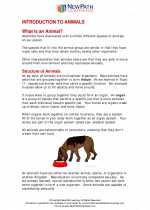 Introduction to Animals
Introduction to Animals  Activity Lesson
Activity Lesson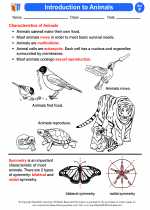 Introduction to Animals
Introduction to Animals  Worksheet/Answer key
Worksheet/Answer key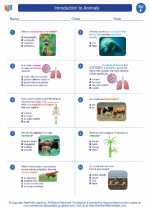 Introduction to Animals
Introduction to Animals  Worksheet/Answer key
Worksheet/Answer key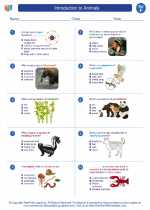 Introduction to Animals
Introduction to Animals  Worksheet/Answer key
Worksheet/Answer key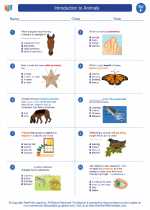 Introduction to Animals
Introduction to Animals  Vocabulary/Answer key
Vocabulary/Answer key Introduction to Animals
Introduction to Animals  Vocabulary/Answer key
Vocabulary/Answer key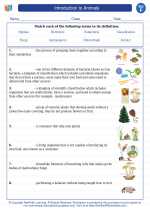 Introduction to Animals
Introduction to Animals  Vocabulary/Answer key
Vocabulary/Answer key Introduction to Animals
Introduction to Animals  Vocabulary/Answer key
Vocabulary/Answer key Introduction to Animals
Introduction to Animals 

 Activity Lesson
Activity Lesson
 Worksheet/Answer key
Worksheet/Answer key
 Worksheet/Answer key
Worksheet/Answer key
 Worksheet/Answer key
Worksheet/Answer key
 Vocabulary/Answer key
Vocabulary/Answer key
 Vocabulary/Answer key
Vocabulary/Answer key
 Vocabulary/Answer key
Vocabulary/Answer key
 Vocabulary/Answer key
Vocabulary/Answer key

The resources above cover the following skills:
LIFE SCIENCE
From Molecules to Organisms: Structures and Processes